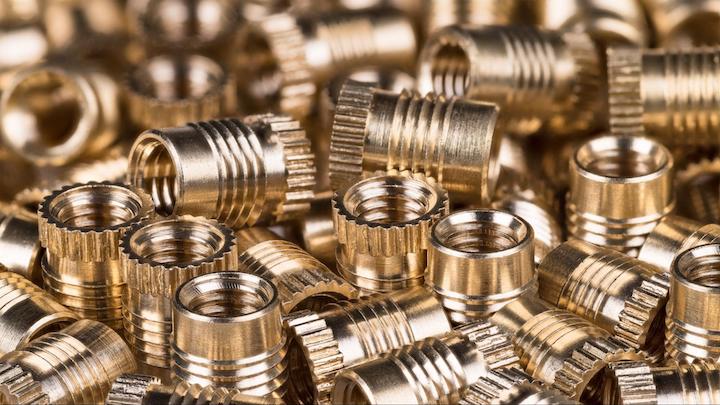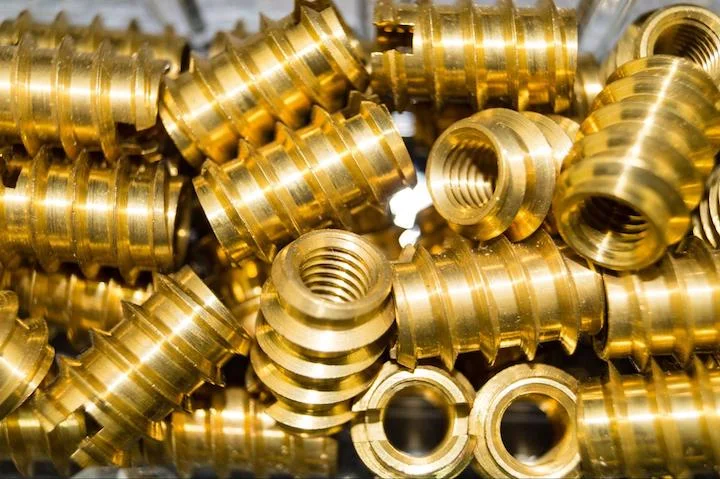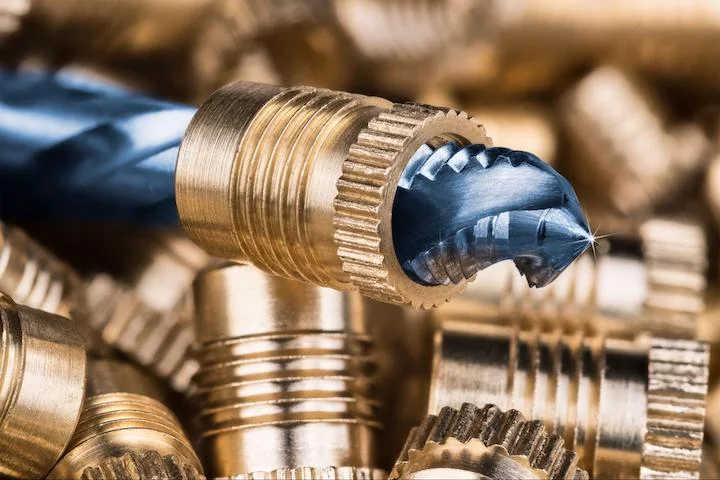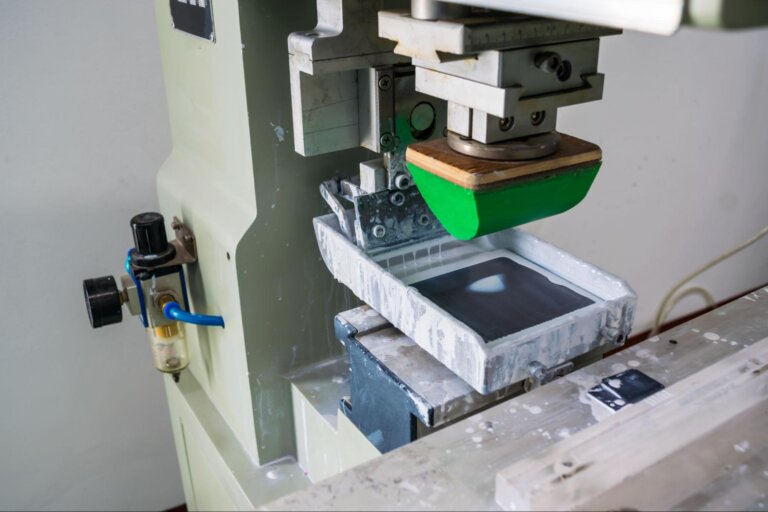Time to read: 6 min
When designing robust 3D-printed assemblies, you need a comprehensive understanding of the optimal ways to assemble different components. And when it comes to securing 3D-printed parts, Metal inserts are a superior method as opposed to 3D printing threads, which often result in subpar connections.
This article will delve into the various types of inserts, strategies for designing parts that use them, and their installation.

Figure 1: Bronze Threaded Inserts
Many different types of inserts are compatible with 3D-printed parts, and this article discusses the most common types:
- Heat insert
- Threaded inserts
- Hex nuts
- Press-fit inserts
Heat Inset Thread Inserts
Heat-inset metal thread inserts come in various designs, with some featuring male threads and others with female threads. Regardless of the thread type, all insert designs have bosses on the external diameter to help embed them securely in the heated, softened plastic. Many varieties of off-the-shelf insert designs are available from suppliers, but they all achieve the same end goal.
Heat inset thread inserts are typically made from brass because it’s easy to manufacture and is an excellent thermal conductor — meaning it transmits heat more effectively for easier installation.
Installation with Applied Heating Via Soldering Iron
Heating is the recommended method for installing these types of inserts, as it results in the most secure connection. The inserts are designed to be heated just enough to melt the surrounding plastic during installation. This molten plastic then flows around the bosses on the outside diameter of the insert, creating a secure mechanical lock once cooled. The process starts with placing the insert on a slightly undersized hole. A soldering iron is then held against the insert until it’s hot enough to be pressed into the part.
Pro-Tip: There are off-the-shelf inserts designed to nest into specific soldering iron tips, like this one. Also, always check for material compatibility and ensure your soldering iron settings are high enough to sufficiently soften, but not thoroughly melt the 3D-printed part.
Installation of a Pre-Heated Insert with a Drill Press
Alternatively, inserts can be secured on the end of a threaded rod attached to the chuck of a drill press. Inserts can be heated with a butane torch, and then precisely installed in the part. This method results in inserts perpendicular to the part, and their depth can be precisely controlled. However, the drill press must not be lifted before the plastic has cooled, as this risks pulling the insert out.
Installation Using an Ultrasonic Soldering Iron
Ultrasonic soldering irons can also be used to install inserts. These irons work by vibrating the inserts at a high frequency, which causes the plastic to melt wherever it contacts the insert — allowing for precise heating and installation.
Threaded Fitting Inserts
An alternative to heat-inset fittings is threaded fittings. These have an external thread that can be screwed into the 3D-printed part without heating them first. However, the insert holes must be correctly sized to prevent breaking the part due to a stress buildup during installation. Hole walls also must be thick enough to allow for the threads to cut into it without piercing through.
This technique is ideal for parts made from thermosetting plastics — like those typical with stereolithography printing — that do not re-solidify after melting (versus thermoplastic ones that do). Some thermosetting plastics, like resin-based plastics, can be brittle, so care must be taken during installation. Note that using heat set inserts in thermosetting plastic is not a good idea — the plastic will crumble away instead of deforming around the bosses on the exterior of the insert.
Tapping a hole and installing an insert is the strongest bond you will get with threaded fitting inserts. Alternative installation techniques include using an adhesive or directly screwing the insert into the part.

Figure 2: Threaded Inserts
Hex Nuts
Standard hex nuts can be inserted into 3D-printed parts as a cheap, easy-to-install alternative to threaded or heat-inset inserts. In most cases, hex nuts are inserted into parts before they’re finished printing. This can be done by inserting relevant hold commands in the G-code so that prints will pause for the nuts to be inserted. If the nut is completely captive, the hole can be slightly oversized, because there’s no chance of it falling out. However, if the nut is installed on the outer face of a 3D print, then it may be necessary to design a slight interference fit so the nut doesn’t fall out.
Protip: When using a hex nut inserts, the fastener must pull the nut against the part. Unlike press-fit, heat inset, or threaded inserts, hex nuts can easily be pulled out by the screw, even with a slight interference fit.
You can also use epoxy or another adhesive to secure a nut. However, these types of bonds are limited to the adhesive and surface preparation strength, and the pullout strength is limited to the strength of the plastic surrounding the nut.
Press-Fit Inserts
Press-fit inserts are an alternative to threaded inserts for thermosetting plastics. They’re installed by pressing the insert into a slightly undersized hole using a drill press or purpose-built manual press. However, the exact interference depends on the material and the design of the insert — too much interference can cause the part to fail under the pressure of the press fit.

Design Guidelines
First off, best practice is to print a test piece to ensure your chosen hole sizes are correct. What follows are some common variables to consider when designing 3D-printed parts to utilize inserts.
Type of Plastic
Not all plastics are compatible with every type of insert. For example, only thermoplastics like ABS, PLA, or PETG are compatible with heat-inset inserts because the plastic will solidify after melting, securing the insert in place. Thermosetting plastics, like those used in SLA (Stereolithography) printing, will not re-solidify after melting, so heat-inset inserts will create a compromised connection. SLA parts are better suited to captive nuts, press-fit, and threaded inserts.
Hole Diameter & Depth
The hole diameter and depth are the most important factors to consider when designing insert connections. The hole diameter depends on the type of inset used. Most suppliers will provide a hole size and depth chart for their various insert sizes for heat-inset brass fittings. The hole size is smaller than the outer diameter of the insert, and the depth of the hole is typically slightly longer than the length of the insert.
Press-fit inserts require a slightly undersized hole. The exact interference fit depends on the base material and insert type, but ost suppliers will provide a chart with the required diameters and depths.
Measuring the nut before designing the cavity for hex nuts is best. Most nuts are manufactured within a tolerance range and may be slightly smaller or larger than the standard dimensions. Because the nut is captive, the cavity’s size can be slightly larger than the nut — a 0.05 mm clearance usually works well.
Common Challenges
Listed below are some typical challenges you’ll face when using inserts in 3D-printed parts:
- Overheating: Overheating inserts can melt a larger portion of plastic during installation, which can cause the insert to be installed too deeply or cause it to deviate from its optimal position. Overheating can also cause plastic to bulge around the sides of the insert.
Incorrectly installed heat-inset inserts can be removed by using extraction tips, which are threaded soldering iron tips. During removal, the tip is screwed into the insert, and once hot enough, it can be extracted from the part.
- Askew Inserts: If inserts are installed askew — which is especially common if they’re overheated or if a soldering iron is used — they can cause subsequent fasteners to be misaligned and create untidy and subpar connections. In some cases, askew inserts can completely prevent the installation of a fastener.
- Sidewall Placement: Placing inserts too close to the edge of the part will create a noticeable bulge on the face next to the insert. As such, they should be installed at least a half insert diameter or more from the edge.
- Incorrect Hole Size: Making holes too large can result in the inserts being too loose, and consequently, too easily pulled out. However, if the holes are too small, the part can break with press-fit or threaded inserts — and for heat-inset fittings, excess plastic may enter the inner diameter of the insert and prevent the fastener from fitting.
Succeeding With 3D Printed Inserts
Inserts are an excellent way to fasten 3D-printed components together because they provide solid connections and give parts a professional finish. At Fictiv, we have highly skilled manufacturing partners that understand and are proficient at installing every kind of insert for 3D-printed parts. We also have production experts to that can help you refine your 3D-printed designs for both prototyping and scaled production.
Create your free Fictiv account and request a 3D printing quote today — we produce complex parts at ridiculous speeds!










